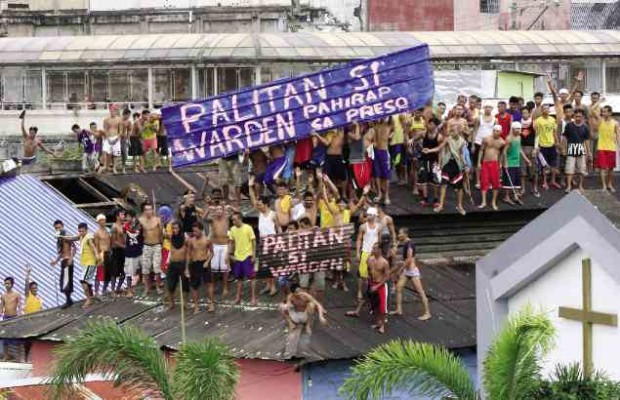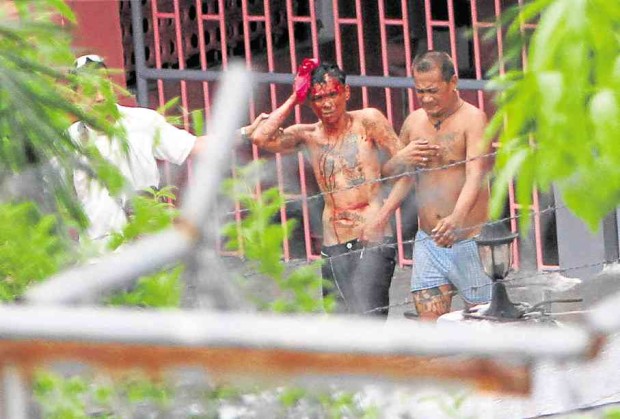No stopping ‘segregation’ of drug suspects in jail

HEIGHT OF PROTEST Manila City Jail inmates climb onto the roof of their dormitories to call for the warden’s ouster through a noise barrage on Thursday morning. —RICHARD A. REYES
The noise barrage and ensuing violence that hurt at least 30 inmates at Manila City Jail on Thursday morning will not stop officials from segregating some 2,000 detainees who are facing drug-related charges.
The Bureau of Jail Management and Penology (BJMP) made this assertion after containing the disturbance, which the bureau said was staged to oppose the segregation plan.
The inmates, however, were also demanding the removal of the warden, the same official who earlier supervised another city jail where a grenade exploded and killed 10 detainees in August.
Thursday’s noise barrage at the Manila jail peaked around 10 a.m., with scores of inmates climbing onto the roof of some of the buildings within the compound.
Journalists who had a view of the roofs saw one man, his face covered with a handkerchief, beating a shirtless inmate into submission with a steel pipe. Some of the inmates’ relatives who were outside the facility at the time recalled hearing gunshots.
Article continues after this advertisementArticle continues after this advertisement
‘Who’s in charge?’
“That can’t be,” said BJMP spokesperson Senior Insp. Xavier Solda, referring to the opposition to the planned segregation. “Who’s in charge of the jail facility? It’s the BJMP. (The inmates) can’t dictate the terms.”
A BJMP statement said about 200 inmates from Dorm 9 and 10 took part in the noise barrage. According to Solda, they grew restive after being informed that those charged with drug-related offenses would be separated from the rest.
The protesters “voluntarily went down” and returned to their cells at 11 a.m. after talks with jail officials, he added.
14 dorms, 4 gangs
But at least 30 inmates—all members of Batang City Jail—were hurt, according to the warden, Supt. Gerald Bantag.
The BJMP would definitely push through with the segregation “for their own good,” Solda said, noting that “the general population is OK with it.”
The city jail currently holds 3,927 male inmates in 14 dormitories, of which seven are occupied by four gangs. More than half of the detainees—or around 2,000—are on trial for drug offenses, according to Senior Insp. Antonio Gayagaya, the jail spokesperson.
Solda said the segregation would enable the BJMP to implement specific programs for these detainees, including those geared toward their rehabilitation. The BJMP statement cited therapy and physical fitness programs, counseling, and spiritual enhancement activities as examples.
“It’s difficult [to implement these programs] if the inmates are all together,” Solda explained. In a mixed group, he added, “sometimes a drug offender can have a negative influence on a fellow inmate who is in jail for theft.”
The order to segregate came from Director Serafin Barretto Jr., who was appointed BJMP chief in August. It is already being carried out in some of the 464 jails run by the bureau nationwide.
Citing the directive, Gayagaya said all drug suspects would be placed in one area regardless of their gang affiliation.
But some of the inmates’ relatives who spoke to reporters warned that the measure could lead to more riots.
They also recalled hearing gunshots coming from the jail compound, but Gayagaya denied that the jail officers fired guns.
Another clamor
They also claimed that the inmates were also seeking the removal of Supt. Gerald Bantag as warden.
Bantag is previously the warden of Paranaque City jail, where 10 inmates were killed in a grenade explosion at his office in August. Investigators then said the inmates had managed to smuggle guns into the jail and were planning to take Bantag hostage.
According to the relatives, since Bantag took over at the Manila jail, visitors had been prevented from bringing food to the detainees and were instead pointed to the stores found inside the jail where food items are “more expensive.”
Gayagaya denied that such a policy was in place.
